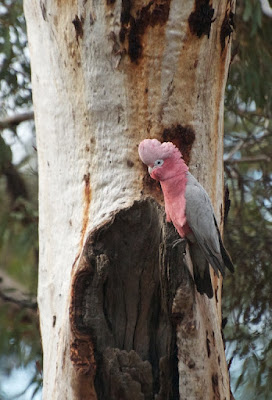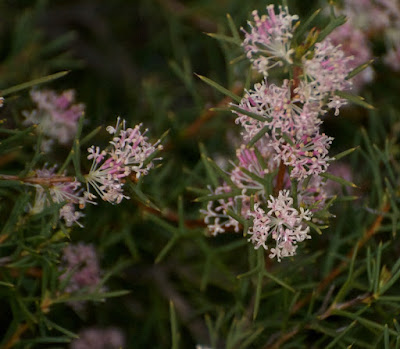The morning of September 17, 2013, found our little group heading east again from Jurien Bay for another day of immersion in the Western Australian spring flora. Once again (for the last time, though, at least for this Western Australian trip) it will take several posts to share it all.
On the first week of our circuit through southwestern Australia, when Eileen and I traveled on our own south and west from Perth, we had several times found ourselves in a type of open eucalyptus woodland dominated by Wandoo (Eucalyptus wandoo). Our first stop for the day found us back in it again, this time in the pleasant little Coomallo Creek Rest Area (just south of the junction of Jurien Road and the Brand Highway, in case you are looking for it).
A boardwalk led into the stand of Wandoo bordering the creek itself.
This warning sign helpfully advises you of what, I suppose, is one of the occupational hazards of visiting an area with plenty of wildflowers.
I believe that this is a sprig of Wandoo; in any case, it demonstrates that eucalypt woodland turns out a lot of fruit that we find inedible, but that cockatoos devour with gusto.
To prove my point, the place was full of Galahs (Eolophus roseicapilla).
Australian Ringnecks (Barnardius zonarius) were here too, though they are hardly dependent on eucalypts for food (they eat a wide range of fruits and seeds, as do the Galahs). What they and the Galahs both need, though, are large trees with nesting hollows, something very hard to come by in the heathlands but readily available among the Wandoos.
The woodands were also a good place to find fungi, something we had seen little of on our flower-watching quests. This one may be Witches' Butter (Tremalla mesenterica), a jellylike fungus found almost worldwide, or something similar.
This one is a more typical mushroom; perhaps an Amanita of some kind?
And this is the remains of an earthstar (Family Geastraceae), its spores already dispersed and its soft central spore sac disintegrated.
The Wandoo woodland grows in a narrow band, following the banks of Coomallo Creek. Beyond it lies more Kwongan heathland, and more flowers, things far more interesting to my companions than a bunch of Galahs.
Admittedly the flower-laden pink bushes were hard to ignore; this is one of Myrtaceae, perhaps Large-flowered Baeckea (Baeckea grandiflora) but I cannot be sure.
Also in the myrtle family were the delicate white stamens of a Melaleuca, presumably M. concreta.
As usual in the heathlands, myrtles largely shared the shrub layer with proteas (Proteaceae). This one is Honey Bush (Hakea lissocarpha): attractive, aromatic, and very prickly.
At ground level we found the usual coneflowers (Conostylis sp)....
...the by now familiar Cowslip Orchid (Caladenia flava)...
...and the drooping little flowers of Purple Tassels (Sowerbaea laxiflora), all plants we had seen many times before, but still worth a look and a photograph (who knows if we will pass this way again?).
I close with a weed: Blowfly Grass (Briza maxima) is a native of North Africa, widely introduced into other parts of the world. It is, however, one of the few grasses that even I can identify, and (to me at least) that counts for something.
A boardwalk led into the stand of Wandoo bordering the creek itself.
This warning sign helpfully advises you of what, I suppose, is one of the occupational hazards of visiting an area with plenty of wildflowers.
I believe that this is a sprig of Wandoo; in any case, it demonstrates that eucalypt woodland turns out a lot of fruit that we find inedible, but that cockatoos devour with gusto.
To prove my point, the place was full of Galahs (Eolophus roseicapilla).
Australian Ringnecks (Barnardius zonarius) were here too, though they are hardly dependent on eucalypts for food (they eat a wide range of fruits and seeds, as do the Galahs). What they and the Galahs both need, though, are large trees with nesting hollows, something very hard to come by in the heathlands but readily available among the Wandoos.
The woodands were also a good place to find fungi, something we had seen little of on our flower-watching quests. This one may be Witches' Butter (Tremalla mesenterica), a jellylike fungus found almost worldwide, or something similar.
This one is a more typical mushroom; perhaps an Amanita of some kind?
And this is the remains of an earthstar (Family Geastraceae), its spores already dispersed and its soft central spore sac disintegrated.
The Wandoo woodland grows in a narrow band, following the banks of Coomallo Creek. Beyond it lies more Kwongan heathland, and more flowers, things far more interesting to my companions than a bunch of Galahs.
Admittedly the flower-laden pink bushes were hard to ignore; this is one of Myrtaceae, perhaps Large-flowered Baeckea (Baeckea grandiflora) but I cannot be sure.
Also in the myrtle family were the delicate white stamens of a Melaleuca, presumably M. concreta.
As usual in the heathlands, myrtles largely shared the shrub layer with proteas (Proteaceae). This one is Honey Bush (Hakea lissocarpha): attractive, aromatic, and very prickly.
At ground level we found the usual coneflowers (Conostylis sp)....
...the by now familiar Cowslip Orchid (Caladenia flava)...
...and the drooping little flowers of Purple Tassels (Sowerbaea laxiflora), all plants we had seen many times before, but still worth a look and a photograph (who knows if we will pass this way again?).
I close with a weed: Blowfly Grass (Briza maxima) is a native of North Africa, widely introduced into other parts of the world. It is, however, one of the few grasses that even I can identify, and (to me at least) that counts for something.



























No comments:
Post a Comment